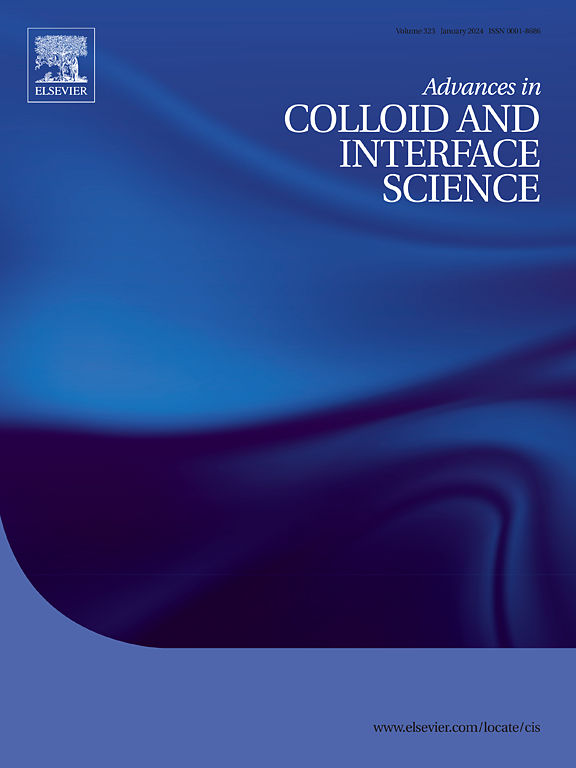多孔介质非混相驱替过程中侵前面演化规律及控制方法:扩大扫体积
IF 19.3
1区 化学
Q1 CHEMISTRY, PHYSICAL
引用次数: 0
摘要
非混相流体在多孔介质中的侵面演化决定了其波及体积,是油气田开发、CO2地质封存、地下储能等领域面临的必然课题。表征多孔介质中非混相流体入侵前沿形态,揭示多因素影响下的孔喉流动机理,探索扩大扫体积的有效控制方法是当前和未来的研究重点。在此,本文从入侵前沿的室内研究方法出发,对该课题的整个生命周期进行了详细的回顾。首先,对物理模拟和数值模拟的研究方法进行了比较,详细分析了三种典型物理模型的优缺点;其次,详细介绍了入侵锋形态法和分形维数法等入侵锋类型判别方法,并对其分类结果的可靠性进行了验证;在此基础上,详细讨论了流体参数、注入参数和模型参数3大类因素及7个子因素对侵入前缘演化的影响,探索并揭示了侵入前缘孔喉流动机理。总结了侵入前缘孔喉流动特性随接触角的连续变化图;第三,对已有的LogM-LogCa经典相图进行了总结和比较,结合毛细力和黏性力的主控分区,分析了各种入侵锋型的分布特征;同时,分析了基于润湿性、孔喉紊乱、壁面粗糙度等因素的其他类型相图。回顾总结的相图涵盖了所有影响因素,并说明了其建立过程和注意事项;其次,根据气体重力差、粘度差和溶解度,简要分析了气体侵入过程的独特性;最后,在上述研究内容的基础上,提出了相应的侵前指控方法,重点研究了脉冲注入法的作用机理和应用效果。施加力场和电场等物理方法是抑制指法和扩大扫描体积的一种潜在的、干净的方法。本文综述内容涵盖基础模型、图像处理、理论分析、技术前沿动态等,适合相关领域研究人员进行基础认知和深度学习。此外,主要控制因素和指法机制随润湿角变化的图表是本文的两个主要贡献和新的见解。本文对扩大波及体积提高油气采收率和地下储液的研究具有重要的指导作用。本文章由计算机程序翻译,如有差异,请以英文原文为准。

Evolution law and control method of invasion front surface during the immiscible displacement in porous media: Expanding the swept volume
The invasion front evolution of immiscible fluids in porous media determines its swept volume, which is an inevitable topic faced by oil and gas field development, CO2 geological sequestration, and underground energy storage. Characterizing the morphology of the invasion front of immiscible fluids in porous media, revealing the pore throat flow mechanism under the influence of multiple factors, and exploring efficient control methods to expand swept volume are the current and future research focuses. Here, starting from the indoor research methods of the invasion front, this paper gives a detailed review of the entire life cycle of this topic. First, the physical simulation and numerical simulation research methods were compared, and the advantages and disadvantages of three typical physical models were analyzed in detail; secondly, the invasion front type discrimination methods such as the invasion front morphology method and the fractal dimension method were introduced in detail, and the reliability of their classification results was verified; then, the influence of three major categories (fluid parameters, injection parameters and model parameters) and seven sub-factors on the evolution of the invasion front were discussed in detail, and the pore throat flow mechanism of the invasion front was explored and revealed. The continuous change diagram of pore throat flow behavior of the invasion front relative to the contact angle was summarized; thirdly, the existing LogM-LogCa classic phase diagrams were summarized and compared, and the distribution characteristics of various invasion front patterns were analyzed in combination with the main control zoning of capillary force and viscosity force; Meanwhile, other types of phase diagrams based on wettability, pore throat disorder, wall roughness and other factors were analyzed. The phase diagrams reviewed and summarized cover all influencing factors, and explain their establishment process and precautions; next, a brief analysis of the uniqueness of the gas invasion process is made based on gas gravity differences, viscosity differences, and solubility; finally, based on the above research content, a corresponding invasion front fingering control method is proposed, mainly focusing on the mechanism and application effect of the pulse injection method. Physical methods such as applied force field and electric field are a potential and clean way to suppress fingering and expand swept volume. The review content of this paper covers basic models, image processing, theoretical analysis, and technological frontier dynamics, which is suitable for researchers in related fields to conduct basic cognition and in-depth learning. In addition, the diagrams of the main controlling factors and fingering mechanisms changing with the wetting angle are two major contributions and new insights of this review. This paper plays a key guiding role in the research of improving oil and gas recovery and underground fluid storage based on expanding swept volume.
求助全文
通过发布文献求助,成功后即可免费获取论文全文。
去求助
来源期刊
CiteScore
28.50
自引率
2.60%
发文量
175
审稿时长
31 days
期刊介绍:
"Advances in Colloid and Interface Science" is an international journal that focuses on experimental and theoretical developments in interfacial and colloidal phenomena. The journal covers a wide range of disciplines including biology, chemistry, physics, and technology.
The journal accepts review articles on any topic within the scope of colloid and interface science. These articles should provide an in-depth analysis of the subject matter, offering a critical review of the current state of the field. The author's informed opinion on the topic should also be included. The manuscript should compare and contrast ideas found in the reviewed literature and address the limitations of these ideas.
Typically, the articles published in this journal are written by recognized experts in the field.

 求助内容:
求助内容: 应助结果提醒方式:
应助结果提醒方式:


